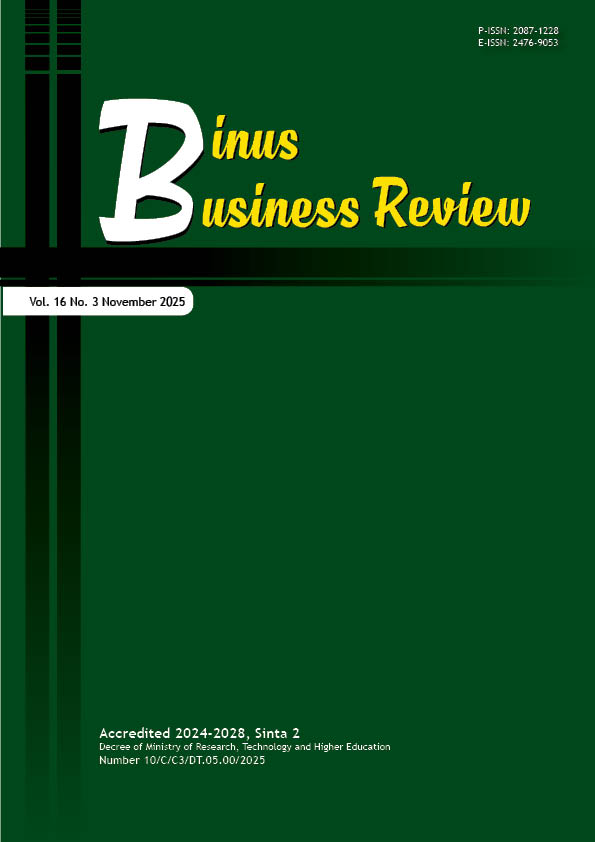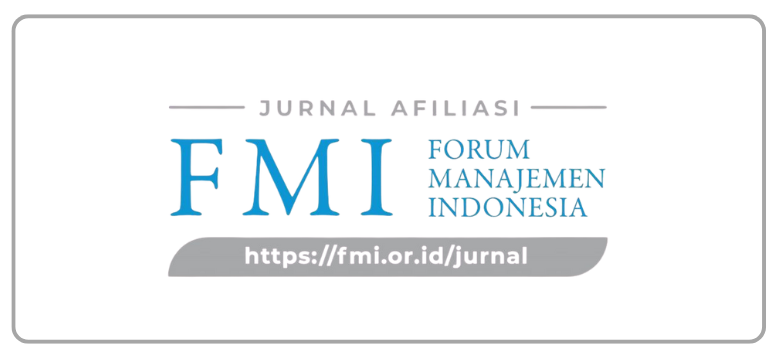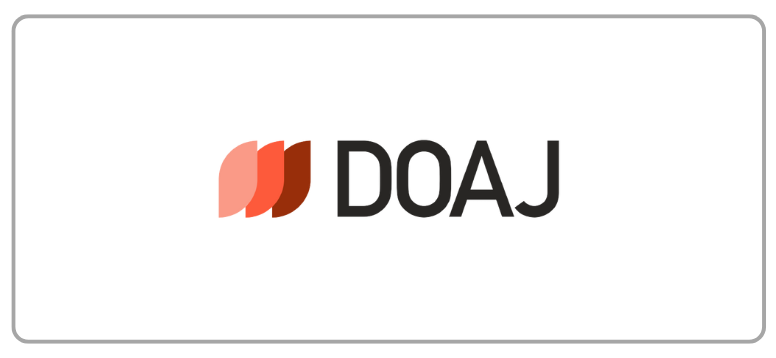Market Orientation, Competitive Environment, and Value Creation in Private Higher Education: Evidence from Palembang During COVID-19
DOI:
https://doi.org/10.21512/bbr.v16i3.13606Keywords:
market orientation, competitive environment, value creation, private higher educationAbstract
The research addressed a gap in the literature by examining how market orientation and competitive environment jointly influenced value creation and marketing performance in private Higher Education Institutions (HEIs), a relationship that remained underexplored, particularly in emerging economies during the COVID-19 recovery period. While previous studies had examined market orientation or competitive factors in isolation, few had integrated these constructs with the mediating role of value creation in the context of service marketing for HEIs. Data were collected through purposive sampling from 225 students enrolled in private universities in Palembang, South Sumatra, Indonesia, between July and September 2023. Ordinary Least Squares (OLS) regression was employed due to the observed variables, relatively small sample size, and the need for a parsimonious model estimation. The findings show that the competitive environment significantly enhances value creation, whereas market orientation does not significantly affect value creation. Then, market orientation has a direct positive impact on marketing performance, while the competitive environment exerts a negative influence. Moreover, value creation partially mediates the relationship between competitive environment and marketing performance, but not between market orientation and marketing performance. These results highlight the strategic role of value creation in navigating environmental challenges and sustaining marketing effectiveness. The research contributes to the literature by integrating competitive environment into the market orientation–performance framework in the under-researched context of Indonesian private HEIs. It also offers practical implications for institutional leaders aiming to align strategic orientation with value-driven initiatives to enhance competitiveness.
References
Aboramadan, M., Dahleez, K. A., & Farao, C. (2022). Inclusive leadership and extra-role behaviors in higher education: Does organizational learning mediate the relationship? International Journal of Educational Management, 36(4), 397–418.
Ayoo, P. O. (2023). The impact of COVID-19 on higher education in Africa. In International encyclopedia of education. Elsevier Inc. https://doi.org/10.1016/B978-0-12-818630-5.02095-9
Broccardo, L., & Zicari, A. (2020). Sustainability as a driver for value creation: A business model analysis of small and medium entreprises in the Italian wine sector. Journal of Cleaner Production, 259. https://doi.org/10.1016/j.jclepro.2020.120852
Cantele, S., & Cassia, F. (2020). Sustainability implementation in restaurants: A comprehensive model of drivers, barriers, and competitiveness-mediated effects on firm performance. International Journal of Hospitality Management, 87. https://doi.org/10.1016/j.ijhm.2020.102510
Capponi, G., Corrocher, N., & Zirulia, L. (2021). Personalized pricing for customer retention: Theory and evidence from mobile communication. Telecommunications Policy, 45(1). https://doi.org/10.1016/j.telpol.2020.102069
Dabbous, A., Barakat, K. A., & Kraus, S. (2023). The impact of digitalization on entrepreneurial activity and sustainable competitiveness: A panel data analysis. Technology in Society, 73, 1–13. https://doi.org/10.1016/j.techsoc.2023.102224
De Jong, A., De Ruyter, K., Keeling, D. I., Polyakova, A., & Ringberg, T. (2021). Key trends in business-to-business services marketing strategies: Developing a practice-based research agenda. Industrial Marketing Management, 93, 1–9. https://doi.org/10.1016/j.indmarman.2020.12.004
Dimitrios, B., Ioannis, R., Angelos, N., & Nikolaos, T. (2023). Digital marketing: The case of digital marketing strategies on luxurious hotels. Procedia Computer Science, 219, 688–696. https://doi.org/10.1016/j.procs.2023.01.340
Du, Y., Kim, P. H., Fourné, S. P. L., & Wang, X. (2022). In times of plenty: Slack resources, R&D investment, and entrepreneurial firms in challenging institutional environments. Journal of Business Research, 145, 360–376. https://doi.org/10.1016/J.JBUSRES.2022.03.004
Ed-Dafali, S., Al-Azad, M. S., Mohiuddin, M., & Reza, M. N. H. (2023). Strategic orientations, organizational ambidexterity, and sustainable competitive advantage: Mediating role of industry 4.0 readiness in emerging markets. Journal of Cleaner Production, 401. https://doi.org/10.1016/j.jclepro.2023.136765
Erhan, T. P., Van Doorn, S., Japutra, A., & Ekaputra, I. A. (2024). Digital marketing innovation and firm performance: The role of decision-making comprehensiveness in dynamic environments. Asia Pacific Journal of Marketing and Logistics, 36(2), 435–456. https://doi.org/10.1108/APJML-01-2023-0097
Estébanez, R. P., Grande, E. U., Cañizares Espada, M., Villacorta, M. Á., Lorain, M. A., & Martín, G. R. (2023). Rethinking international cooperation in higher education institutions, in the post COVID world from the student’s perspective. International Journal of Educational Development, 98, 1–7. https://doi.org/10.1016/j.ijedudev.2023.102750
Falahat, M., Ramayah, T., Soto-Acosta, P., & Lee, Y. Y. (2020). SMEs internationalization: The role of product innovation, market intelligence, pricing and marketing communication capabilities as drivers of SMEs’ international performance. Technological Forecasting and Social Change, 152. https://doi.org/10.1016/j.techfore.2020.119908
Fauzi, M. A., Tan, C. N. L., Muhamad Tamyez, P. F., Abd Aziz, N. A., & Wider, W. (2024). Women leadership in higher education: past, present and future trends. Asian Education and Development Studies, 13(2), 117–133. https://doi.org/10.1108/AEDS-11-2023-0168
Font, X., English, R., Gkritzali, A., & Tian, W. (2021). Value co-creation in sustainable tourism: A service-dominant logic approach. Tourism Management, 82. https://doi.org/10.1016/j.tourman.2020.104200
Gao, W., Li, W., Fan, H., & Jia, X. (2021). How customer experience incongruence affects omnichannel customer retention: The moderating role of channel characteristics. Journal of Retailing and Consumer Services, 60. https://doi.org/10.1016/j.jretconser.2021.102487
Ghamrawi, N., Abu-Shawish, R. K., Shal, T., & Ghamrawi, N. A. R. (2024). Destructive leadership behaviors: The case of academic middle leaders in higher education. International Journal of Educational Research, 126, 1–10. https://doi.org/10.1016/j.ijer.2024.102382
Gotteland, D., Shock, J., & Sarin, S. (2020). Strategic orientations, marketing proactivity and firm market performance. Industrial Marketing Management, 91, 610–620. https://doi.org/10.1016/j.indmarman.2020.03.012
Guerrero, M., Heaton, S., & Urbano, D. (2021). Building universities’ intrapreneurial capabilities in the digital era: The role and impacts of Massive Open Online Courses (MOOCs). Technovation, 99. https://doi.org/10.1016/j.technovation.2020.102139
Hair Jr., J. F., Hult, G. T. M., Ringle, C. M., Sarstedt, M., Danks, N. P., & Ray, S. (2021). Partial Least Squares Structural Equation Modeling (PLS-SEM) using R: A workbook. Springer. https://doi.org/10.1007/978-3-030-80519-7
Haleem, A., Javaid, M., Qadri, M. A., & Suman, R. (2022). Understanding the role of digital technologies in education: A review. Sustainable Operations and Computers, 3, 275–285. https://doi.org/10.1016/J.SUSOC.2022.05.004
Heffernan, T., Eacott, S., & Bosetti, L. (2021). Higher education leadership and context: A study of university vice-chancellors and presidents. International Journal of Educational Management, 35(5), 1063–1073. https://doi.org/10.1108/IJEM-02-2021-0061
Huang, Y. C. (2022). How marketing strategy, perceived value and brand image influence WOM outcomes—The sharing economy perspective. Journal of Retailing and Consumer Services, 68. https://doi.org/10.1016/j.jretconser.2022.103071
Jameson, J., Rumyantseva, N., Cai, M., Markowski, M., Essex, R., & McNay, I. (2022). A systematic review and framework for digital leadership research maturity in higher education. Computers and Education Open, 3, 1–27. https://doi.org/10.1016/j.caeo.2022.100115
Kohli, A. K., & Jaworski, B. J. (1990). Market orientation: The construct, research propositions, and managerial implications. Journal of Marketing, 54(2), 1–18. https://doi.org/10.2307/1251866
Kotler, P., Pfoertsch, W., & Sponholz, U. (2021). H2H marketing: The genesis of human-to-human marketing. Springer. https://doi.org/10.1007/978-3-030-59531-9
Le Thanh, H., Doan Ngoc, T., & To Trung, T. (2022). How to improve the survivability of environmentally innovative firms: The case of Vietnam's SMEs. Journal of Cleaner Production, 362. https://doi.org/10.1016/j.jclepro.2022.132223
Li, B., Mousa, S., Reinoso, J. R. R., Alzoubi, H. M., Ali, A., & Hoang, A. D. (2023). The role of technology innovation, customer retention and business continuity on firm performance after post-pandemic era in China’s SMEs. Economic Analysis and Policy, 78, 1209–1220. https://doi.org/10.1016/j.eap.2023.05.004
Liang, J., Zhao, Y., Wang, H., Xiao, Z., & Ke, J. (2024). Uncovering merchants’ willingness to wait in on-demand food delivery markets. Transport Policy, 158, 14–28. https://doi.org/10.1016/j.tranpol.2024.09.002
Mohammad, W. M. W., & Wasiuzzaman, S. (2021). Environmental, Social and Governance (ESG) disclosure, competitive advantage and performance of firms in Malaysia. Cleaner Environmental Systems, 2, 1–11. https://doi.org/10.1016/j.cesys.2021.100015
Mothafar, N. A., Zhang, J., Alsoffary, A., Masoomi, B., AL-Barakani, A., & Alhady, O. S. (2024). Digital social responsibility towards digital education of international higher education students' institutions: Digital culture as mediator. Heliyon, 10(17), 1–18. https://doi.org/10.1016/j.heliyon.2024.e36442
Najjar, G., & Ascione, F. J. (2020). Faculty leaders’ views of successful implementation of interprofessional education: A case study. Journal of Interprofessional Education & Practice, 21. https://doi.org/10.1016/j.xjep.2020.100371
Othman, B., He, W., Huang, Z., Xi, J., & Ramsey, T. (2021). The effects on service value and customer retention by integrating after sale service into the traditional marketing mix model of clothing store brands in China. Environmental Technology & Innovation, 23. https://doi.org/10.1016/j.eti.2021.101784
Palmié, M., Rüegger, S., Holzer, M., & Oghazi, P. (2023). The “golden” voice of “green” employees: The effect of private environmental orientation on suggestions for improvement in firms’ economic value creation. Journal of Business Research, 156, 1–12. https://doi.org/10.1016/j.jbusres.2022.113492
Petrou, A. P., Hadjielias, E., Thanos, I. C., & Dimitratos, P. (2020). Strategic decision-making processes, international environmental munificence and the accelerated internationalization of SMEs. International Business Review, 29(5). https://doi.org/10.1016/j.ibusrev.2020.101735
Porter, M. E. (2011). Competitive advantage of nations: Creating and sustaining superior performance. Simon and Schuster.
Qian, J., Lin, P. M. C., Law, R., & Li, X. (2022). Lack of IT and digital marketing professionals in hospitality: Is it education's fault? Heliyon, 8(12), 1–8. https://doi.org/10.1016/j.heliyon.2022.e12002
Quintás, M. A., Martínez-Senra, A. I., & Otero-Giráldez, M. S. (2025). Do technology and market orientations enhance financial performance? A comparison between climate change mitigation and adaptation and other fields. Sustainable Futures, 10, 1–11. https://doi.org/10.1016/j.sftr.2025.100953
Rentschler, M., Hohmann, S., Heuermann, P., Valenti, L., & Miehe, R. (2025). Designing innovation ecosystems for biointelligent value creation – Identification of promising technology fields and pioneer countries. Journal of Open Innovation: Technology, Market, and Complexity, 11(1), 1–16. https://doi.org/10.1016/j.joitmc.2025.100484
Riccomini, F. E., Cirani, C. B. S., Pedro, S. D. C., Garzaro, D. M., & Kevin, K. S. (2021). Innovation in educational marketing: A study applied to Brazilian private higher education institutions. Journal of Marketing for Higher Education, 34(1), 95–115. https://doi.org/10.1080/08841241.2021.1966157
Sahri, Akhyak, & Sujianto, A. (2025). Implementation of the independent campus in enhancing learning autonomy in higher education. International Journal of Islamic Educational Research, 2(4), 1–14.
Samson, K., & Bhanugopan, R. (2022). Strategic human capital analytics and organisation performance: The mediating effects of managerial decision-making. Journal of Business Research, 144, 637–649. https://doi.org/10.1016/j.jbusres.2022.01.044
Scott, T., & Guan, W. (2022). Challenges facing Thai higher education institutions financial stability and perceived institutional education quality. Power and Education, 15(3), 326–340. https://doi.org/10.1177/17577438221140014
Slater, S. F., & Narver, J. C. (2000). The positive effect of a market orientation on business profitability: A balanced replication. Journal of Business Research, 48(1), 69–73. https://doi.org/10.1016/S0148-2963(98)00077-0
Teichler, U. (2023). Internationalization of higher education. In R. J. Tierney, F. Rizvi, & K. Ercikan (Eds.), International encyclopedia of education (Fourth edition) (pp. 239–249). Elsevier. https://doi.org/10.1016/B978-0-12-818630-5.01029-0
Tjahjadi, B., Soewarno, N., Jermias, J., Hariyati, Fairuzi, A., & Anwar, D. N. (2022). Does engaging in global market orientation strategy affect HEIs’ performance? The mediating roles of intellectual capital readiness and open innovation. Journal of Open Innovation: Technology, Market, and Complexity, 8(1), 1–18. https://doi.org/10.3390/joitmc8010029
Uddin, M., Bal, H., & Hoque, N. (2025). Paving the way towards effective entrepreneurship education in private higher educational institutions in emerging economy: An analysis of barriers and strategies. Sustainable Futures, 10, 1–14. https://doi.org/10.1016/j.sftr.2025.101027
Uralov, O. S. (2020). Internationalization of higher education in Uzbekistan. Social Sciences & Humanities Open, 2(1), 1–7. https://doi.org/10.1016/j.ssaho.2020.100015
Vu, U., & Tolstoy, D. (2025). Examining the complementary roles of market-driven and market-driving orientations in the geographical diversification strategies of e-commerce SMEs. Journal of Business Research, 194, 1–15. https://doi.org/10.1016/j.jbusres.2025.115375
Wibowo, A., Chen, S. C., Wiangin, U., Ma, Y., & Ruangkanjanases, A. (2020). Customer behavior as an outcome of social media marketing: The role of social media marketing activity and customer experience. Sustainability, 13(1), 1–18. https://doi.org/10.3390/su13010189
Wu, C. W., Botella-Carrubi, D., & Blanco-González-Tejero, C. (2024). The empirical study of digital marketing strategy and performance in Small and Medium-sized Enterprises (SMEs). Technological Forecasting and Social Change, 200. https://doi.org/10.1016/j.techfore.2023.123142
Xing, P., Jiang, G., Zhao, X., & Wang, M. (2023). Quality effort strategies of video service supply chain considering fans preference and data-driven marketing under derived demand. Electronic Commerce Research and Applications, 62. https://doi.org/10.1016/j.elerap.2023.101338
Yang, M., Al Mamun, A., & Salameh, A. A. (2023). Leadership, capability and performance: A study among private higher education institutions in Indonesia. Heliyon, 9(1), 1–13. https://doi.org/10.1016/j.heliyon.2023.e13026
Yu, X., Liu, T., He, L., & Li, Y. (2023). Micro-foundations of strategic decision-making in family business organisations: A cognitive neuroscience perspective. Long Range Planning, 56(5). https://doi.org/10.1016/j.lrp.2022.102198
Zhao, X., Wider, W., Jiang, L., Fauzi, M. A., Tanucan, J. C. M., Lin, J., & Udang, L. N. (2024). Transforming higher education institutions through EDI leadership: A bibliometric exploration. Heliyon, 10(4), 1–12. https://doi.org/10.1016/j.heliyon.2024.e26241
Zhou, K. Z., Gao, G. Y., Yang, Z., & Zhou, N. (2005). Developing strategic orientation in China: antecedents and consequences of market and innovation orientations. Journal of Business Research, 58(8), 1049–1058. https://doi.org/10.1016/j.jbusres.2004.02.003
Downloads
Published
How to Cite
Issue
Section
License
Copyright (c) 2025 Ahmad Maulana, Catharina Clara, Nurkardina Novalia

This work is licensed under a Creative Commons Attribution-ShareAlike 4.0 International License.
Authors who publish with this journal agree to the following terms:
a. Authors retain copyright and grant the journal right of first publication with the work simultaneously licensed under a Creative Commons Attribution License - Share Alike that allows others to share the work with an acknowledgment of the work's authorship and initial publication in this journal.
b. Authors are able to enter into separate, additional contractual arrangements for the non-exclusive distribution of the journal's published version of the work (e.g., post it to an institutional repository or publish it in a book), with an acknowledgment of its initial publication in this journal.
c. Authors are permitted and encouraged to post their work online (e.g., in institutional repositories or on their website) prior to and during the submission process, as it can lead to productive exchanges, as well as earlier and greater citation of published work.
USER RIGHTS
All articles published Open Access will be immediately and permanently free for everyone to read and download. We are continuously working with our author communities to select the best choice of license options, currently being defined for this journal as follows: Creative Commons Attribution-Share Alike (CC BY-SA)





















